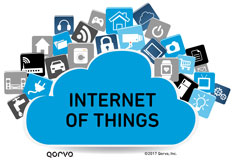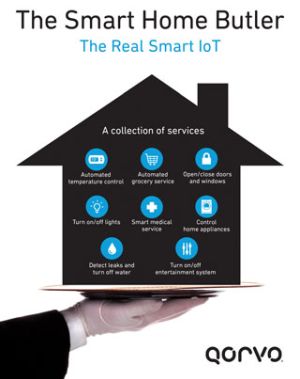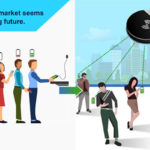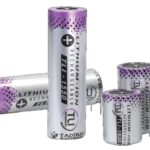Sure, smart lighting will save energy, but they’ll also be the backbone of systems that can help minimize mini-catastrophes.
CEES LINKS, Qorvo
THE IoT (internet of things) INCLUDES a rich offering of energy efficiency benefits. Smart lighting is, of course, one of the most common elements of any IoT energy efficiency discussion. Lighting is a feature throughout every room of every building, and every light fixture connects to a power source.
 The IoT is generally available to every area of the economy. This is a benefit to keep in mind when considering the future of the IoT, particularly for energy efficiency improvements. The IoT’s scalability can bring energy efficiency benefits for all.
The IoT is generally available to every area of the economy. This is a benefit to keep in mind when considering the future of the IoT, particularly for energy efficiency improvements. The IoT’s scalability can bring energy efficiency benefits for all.
The IoT promise of “intelligent buildings” offers the ability to view the operations of commercial buildings and receive the data needed to improve efficiency, lower costs and improve the experience of both management and tenants. The ability to get at this data creates a fundamental shift in how commercial buildings are managed.
Before the IoT, “conventional” building management involved a set of tools like spreadsheets, monthly utility bills and operations procedures. This approach has historically focused more on tracking the operations inside the walls than on optimizing them. (This applies to homeowners, too, by the way. Traditionally, homeowners have focused on getting bills paid and making sure they were “in line”
with expectations.)
But the data-gathering and processing of the IoT offers building managers the ability to go beyond operations tracking and to make better, informed decisions that create efficiencies and save money. (For homeowners the same applies—the IoT offers a new perspective on improving those bills, not just tracking them.) Within the spectrum of IoT-powered features, energy efficiency is crucial to determining intelligent building ROI. Using fewer kilowatt-hours means spending fewer dollars on utilities.
Some smart lighting controls may do far more than simply turn lights on or off. Indoor smart lighting can encompass more than just a motion sensor that detects when someone enters or exits a room. It can also determine where and how many occupants sit in the room and whether the room temperature should be adjusted to allow for them. Use of smart lighting controls, optimized air conditioning and heating, and better indoor air quality add up to real, bottom-line savings.
(Truly) smart homes
IoT-driven savings are available for homeowners as well. The list of smart home energy savers is extensive and includes things like automated schedulers for electronics, lights, and HVAC. But a truly smart power system in a home would go beyond schedules and pre-programmed options. It would monitor and manage how and when power is consumed. It could be used to control the amount of time your kids spend on their electronic devices (and I am sure they will love this feature). It could turn off appliances or power-consuming systems unless they were in use. It might also automatically open and close window shades or curtains to adjust for the sun and the season.
 For consumers who are on time-of-use rate plans, a smart electrical distribution panel can charge a home power-storage system during the day via solar panels or at night when power is less expensive. Then power-greedy appliances can use cheaper electricity from storage instead of from the grid during expensive rate times. These systems, controlled by a master app rather than by individual controls for each feature, already find use in industrial applications and will soon move to home use.
For consumers who are on time-of-use rate plans, a smart electrical distribution panel can charge a home power-storage system during the day via solar panels or at night when power is less expensive. Then power-greedy appliances can use cheaper electricity from storage instead of from the grid during expensive rate times. These systems, controlled by a master app rather than by individual controls for each feature, already find use in industrial applications and will soon move to home use.
An effective smart home can make its occupants smarter, too. People educated about the power consumption of their appliances are more likely to turn them off when not in use and to use them in more energy-thrifty ways. For instance, it’s much more efficient to run washing machines or dishwashers that are filled to capacity. Running appliances half-full wastes power and water, not to mention detergent.
A network of position and motion sensors enables smart homes to control temperature and lighting to accommodate rooms in use. For instance, the system would be smart enough to turn off the lights and the A/C in empty parts of the home of a family huddled around a TV on a hot summer night. It would energize the A/C in the bedrooms when family members head off to bed. Because many people prefer cooler temperatures for sleeping, the system could be smart enough to slowly reduce the temperature at night and then raise it as morning approaches.
For another illustration, imagine someone entering and saying “good evening” to the Alexa Pod. Alexa replies, turns on the A/C, music, a lamp, and lowers the blinds. Later, motion sensors detect the occupant leaving. The movement matches learned patterns, so the smart home system shuts down the music and lights, turning on the bedroom lights as someone enters.
The analytics behind the smart energy system are key. The system learns from the occupants to predict future behaviors. Of course, simple overrides are available, but the smart home absorbs the majority of patterns and uses them to enhance settings for comfort, convenience and cost-savings. The effect is like an electronic butler who knows and anticipates habits—and notices unusual changes in your patterns.
Now consider smart lighting. Smart lighting is one of the most common elements of any IoT energy efficiency discussion. Smart bulbs are becoming more widely available. They connect to the internet and are controlled through apps on a mobile device or computer, rather than by a light switch or dimmer. Smart lighting also plays a role in “soft security” as an anti-burglary device, replacing the electromechanical timers of yesteryear that can give the impression that the house is occupied when nobody is home.
Smart lighting is also useful on the industrial front. For example, large users of artificial light use smart lighting that senses daylight. The sensed natural lighting conditions determine whether connected bulbs are on or off, saving energy.
Additionally, the IoT can bring energy efficiency advantages that are less obvious. Some are in the category of unexpected expenses from accidents and equipment failures. When a water heater starts to go bad, for example, the problem typically manifests itself as a slow leak. This failure can be tricky to identify. In many cases, the water heater continues to run, heating both water for washing and water that is leaking out. This runs up the utility bill. The simplest fix is to install a leak detector that alarms when the tank fails. A better idea is to connect that leak detector to a smart home network that can alert the homeowner and power down the water heater.
Of course, water heater tanks can also rupture and spill gallons of hot water, creating costly damage. Ditto for a frozen water pipe that breaks. A smart home with a water-flow sensor can notice water flowing in the pipes when no one is home. It can warn the homeowner and turn off the water at the main valve, heading off flood damage.
Insurance companies are recognizing that smart homes can potentially reduce claims. By preventing a flood, a smart home system can also prevent the mold resulting from water damage—a common home insurance claim.
The same can be said for natural disasters like earthquakes, tornadoes and hurricanes. Imagine being able to extinguish power, gas and utilities with a single touch of a smartphone. Even better, think of a smart system that recognizes weather alerts and can automatically disconnect appliances and close storm shutters.
Most of us recognize how the smart building can augment security and convenience and boost energy efficiency. But truly smart energy management can limit damage from natural and unnatural disasters, reduce insurance costs, educate people about their power usage, while making life more comfortable and convenient.






Leave a Reply